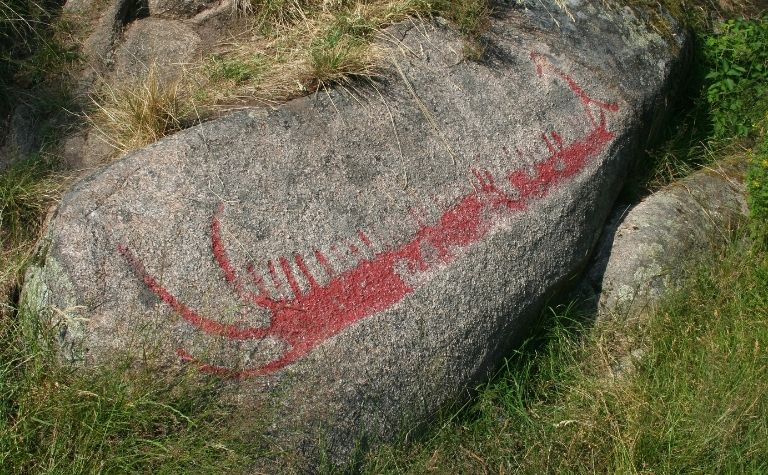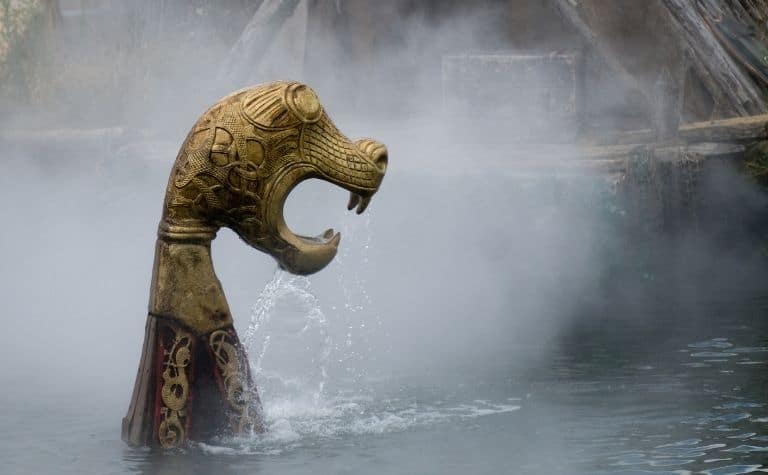While the Vikings are commonly associated with the violent raids and conquests of neighboring regions that occurred during the Viking Age, a forgotten fact is that most Norsemen of that period never saw battle, much less wielded a weapon against another.
Theirs is more than a warrior society that flexed its muscles for several centuries; the Vikings left behind a rich cultural legacy, including distinct art styles.
The Vikings were a very purpose-driven society, and as far as expressing themselves artistically, they did not create art merely for art’s sake.
Their artistic endeavors were either meant to: signify something, convey some type of message, or constitute a form of respect.
Viking artists typically adorned functional objects with their artwork rather than creating standalone pieces solely for display.
Below is a look at seven traditional Viking art styles, working in chronological order from the earliest forms to the latest.

The Broa Style
Time Period: Circa 790-850: Scholars and historians are split on the first identifiable style of traditional Viking art.
While most would seemingly side with the Oseberg style, there are strong proponents of the notion that the first distinctly Viking style of art is the Broa style. (Also see Did Viking Helmets Really Have Horns?)
Named after a grave site in Gotland, Sweden (as is commonly the case with Viking art styles) where artifacts were recovered, the development of the Broa art style likely preceded the Viking Age but comprises various depictions of:
- Animals
- Beasts
- Beings
That is a common thread throughout all styles of Viking art regardless of the time period.
Some general characteristics of the Broa art style include:
- Abstract imagery including animals and patterns
- A free form approach toward composition and subject matter
- Flow and movement of subjects within pieces [1]
As far as particular aspects of the Broa art form, these are the things that stand out:
- Many of the animals depicted in Broa style artwork are unidentifiable (the term “great beasts” is used to refer to these)
- Animals have common features like small heads depicted in profile with protruding eyes and undersized mouths, beaks, and noses
- Animal torsos morph into multiple tendrils, ribbons, or strands that twist and curl about [2]
The Broa style of traditional Viking art coincides with the historically recognized commencement of the Viking Age and marks the beginning of a centuries-long artistic journey. (Also see Did the Vikings Have Cats?)
The Oseberg Style
Time Period: Circa 800 – 875: The Oseberg style takes its name from a famous Viking Age burial site near Tonsberg, Norway, that yielded a treasure trove of Viking artifacts, including:
- The famed Oseberg ship, which was buried with the remains of two prominent women
- Three ornately decorated wooden sleighs
- A horse-drawn cart
- Five intricately carved wooden beast heads
- Clothes and personal items indicating great wealth and status [3]
From many of these items emerged a distinct art form that scholars believe evolved from the Broa style. (Also see 15 Facts About Viking Women)
Note: Some scholars believe that the Oseberg style served as a transitionary period between the Broa style that preceded it and the Borre style that followed.
These are some of the noteworthy attributes of the Oseberg art style:
- Depicted animals and beasts are not as slender and elongated in form (they are stockier)
- The concept of the gripping beast (where animals grip or hold various body parts and other elements of the art piece in their paws or jaws) is more prevalent
- Anatomical elements of depicted animals are not clearly defined, resulting in a jumbled mix of beasts and body parts
- Ribboning of animals and patterns has an almost haphazard arrangement with no symmetry or structure
Like the Broa style that preceded it (the time periods corresponding to the various Viking art styles typically overlapped each other), no instances of the Oseberg style have been found outside of Scandinavia, suggesting that these two forms were truly indigenous to the Vikings and ancient Norse people.

The Borre Style
Time Period: Circa 850 – 975: Named after bronze bridle accessories that were recovered from the Borre burial mound in Vestfold, Norway, the Borre style continues the Viking artistic trend of prominently featured gripping beasts established by the Broa and Oseberg art forms. (Also see The Giants of Norse Mythology)
There are, however, distinct stylistic differences exhibited by the Borre style that demonstrate a clear artistic evolution:
- Unlike its predecessors, the Borre style minimizes the amount of open or blank space in the background, with a greater fill and compact appearance
- There is a greater degree of intertwining and weaving of various elements, be they zoomorphic (depicting animal forms) components or geometric designs
- With respect to depicted creatures, features like heads and faces are noticeably larger, eyes are more prominent, and ears are longer and more tipped [4]
Not only does the Borre style of traditional art show that Viking artists were willing to venture past established artistic boundaries and experiment with new forms, but specimens of this style have also been found outside of Scandinavia, including the British Isles and parts of what is now Russia. (Also see Did the Vikings Worship Odin?)
The Jelling Style
Time Period: Circa 900 – 975
The Jelling art style is associated with an ornately decorated cup that was recovered from a grave site in Denmark that reputedly contained the grave goods of Gorm the Old, viewed by many historians as the first true king of a unified Denmark. [5]
Gorm the Old and his son Harald Bluetooth are credited with erecting and expanding the complex of monuments at Jelling, including the famous Jelling rune stones.
In some ways, the Jelling art form marks a return to earlier Viking styles, including:
- Ribbon animals with distinct, clearly delineated forms are once again prominent
- Animals are depicted with even and balanced proportions
- Features like tendrils and geometric forms and patterns are more orderly and subdued than in the Borre style [6]
Although the Jelling style is a revival of sorts of older Viking art forms, it also introduces novel ideas, most notably the prominent use of “S” patterns in both zoomorphic and geometric elements. (Also see Was Ragnar Lodbrok a Christian?)
The Mammen Style
Time Period: Circa 950 – 1000
Named after a burial chamber uncovered by an unsuspecting farmer in Denmark, the Mammen style is linked to the famed Mammen axe. [7]
This is an iron axe that features intricate silver inlays depicting motifs like the Norse tree of life (Yggdrasil) along with an animal that has been likened to a rooster or Phoenix.
Some scholars have theorized that the Mammen axe draws from Pagan and Christian inspiration.
The Mammen style of traditional Viking art once again demonstrates adherence to certain artistic themes on the one hand and the pushing of boundaries on the other. Some notable characteristics of this style include:
- Animals and birds are depicted in their entirety (not just their heads or upper body)
- Outlines are double-lined, and figures are shaded in with bead or pellet patterns
- Hip joints are marked by spiral-shaped designs
- Prominent use of tendrils, ribbons, and curved lines arranged asymmetrically
- Extensive use of vegetal elements like leaves and twigs
The Mammen style not only demonstrates the intricate and highly polished work of Viking artists but also the continuing evolution of Viking art as a distinct discipline. (Also see What Did the Vikings Actually Look Like?)
The Ringerike Style
Time Period: Circa 1000 – 1075
Unlike the forms of traditional Viking art preceding it, the most prominent examples of Ringerike style art (named after a region in Norway rather than a burial site) are found not in wood carvings or etched metal but rather on engraved stones. (Also see What Hairstyles Did the Vikings Have?)
While the Ringerike style largely picks up where the Mammen style left off, scholars also believe that Ringerike-age artists were inspired by Anglo-Saxon or Ottonian stone carving techniques.
Ringerike art is usually characterized by the following:
- The depiction of fantastic beasts (unidentifiable creatures that are often hybrids of known animals)
- Heavy use of tendrils, ribbons, and wavy lines, often to depict animal fur and tails
- Zoomorphic and geometric forms were embellished with curly ends (this was picked up from Anglo-Saxon and Ottonian styles)
- Snakes and serpent-like creatures appear in many Ringerike pieces, some with non-snake attributes like teeth, ears, and paws
- Some pieces contain simple runes [8]
As evidenced by the Ringerike art style, Viking artists did not hesitate to incorporate techniques and forms learned from other regions into their own pieces. (Also see Did the Vikings Have Red Hair?)
The Urnes Style
Time Period: Circa 1040 – 1100
Named after a stave church in Norway, scholars believe that the Urnes style is actually Swedish in origin, as many examples of this art form have been found on rune stones in Uppland, Sweden.
Regardless of where it came from, the Urnes style is widely accepted as the final chapter of traditional Viking art based on embellished animal depictions.
The Urnes style is characterized by smooth, flowing lines and sophisticated animal forms. Specific attributes include:
- The most common motif in Urnes style pieces is a four-legged beast of a fantastical nature
- Other popular motifs include snakes (and other serpent-like creatures which are often depicted wrapped around the legs of other creatures) and deer-like animals
- The eyes of animals have evolved from round and bulging in previous styles to large and almond-shaped in the Urnes style
Another prominent feature in Urnes style pieces is an elaborate ribbon weaving in and out, among other forms in the piece. [9]
While distinctly Norse in form, the Urnes style of art also enjoyed popularity outside of Scandinavia, most notably in England and Ireland. (Also see 25 Norse Gods to Know)
Conclusion
While they are most famous for their prowess in the art of war, the Vikings left a more lasting legacy through their traditional art styles.
References:
[1] Source
[2] Source
[3] Source
[4] Source
[5] Source
[6] Source
[7] Source
[8] Source
[9] Source
